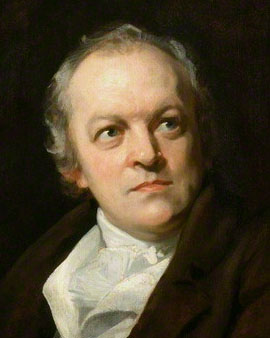Notorious among his contemporaries as an eccentric nutcase, the genius of William Blake, born in London in 1757, was only recognized and honored after his death. Already haunted by visions of angels, demons and ghosts in his childhood, mysticism served the trained engraver throughout his life as inspiration for his artistic and poetic career. After quarrelling with the President of the Royal Academy of Arts, he founded a printing house and published his works himself, together with his wife Catherine, by inventing a special printing technique, relief etching. Typical for Blake was the novel combination of image and writing.
Also because of the visualization of his visions in his works, which were so different from contemporary art, Blake was regarded by his fellow men as a crazy, yet unusually happy person who stood up for equality of the sexes, races and classes. These views, which were dangerous in the politics of the time, were particularly influenced by a liberal interpretation of the Bible, unlike the Church, and the ideas and ideals of the French Revolution, and were far ahead of their time. In his paintings Blake often used religious motifs, such as the Fall of Man in Satan Exulting over Eve and The Temptation and Fall of Eve.
William Blake died in 1827 largely unnoticed and penniless, but is today considered an important artist whose works still influence pop culture.
×





.jpg)
.jpg)
.jpg)
.jpg)
.jpg)
.jpg)
.jpg)
.jpg)
.jpg)
.jpg)
.jpg)
.jpg)
.jpg)
.jpg)
.jpg)
.jpg)
.jpg)
.jpg)
_c1803-05_(b_-_(MeisterDrucke-636435).jpg)
_c1803-05_(b_-_(MeisterDrucke-636435).jpg)
.jpg)
.jpg)
.jpg)
.jpg)
.jpg)
.jpg)
.jpg)
.jpg)
.jpg)
.jpg)
.jpg)
.jpg)
 - (MeisterDrucke-58294).jpg)
 - (MeisterDrucke-58294).jpg)
 - (MeisterDrucke-62372).jpg)
 - (MeisterDrucke-62372).jpg)
_-_(MeisterDrucke-314413).jpg)
_-_(MeisterDrucke-314413).jpg)
.jpg)
.jpg)
.jpg)
.jpg)
.jpg)
.jpg)
.jpg)
.jpg)
.jpg)
.jpg)
.jpg)
.jpg)
.jpg)
.jpg)
.jpg)
.jpg)
.jpg)
.jpg)
.jpg)
.jpg)
.jpg)
.jpg)
.jpg)
.jpg)
.jpg)
.jpg)
.jpg)
.jpg)
.jpg)
.jpg)
 - (MeisterDrucke-55380).jpg)
 - (MeisterDrucke-55380).jpg)
.jpg)
.jpg)
.jpg)
.jpg)
.jpg)
.jpg)
.jpg)
.jpg)
.jpg)
.jpg)
 The Reunio - (MeisterDrucke-671488).jpg)
 The Reunio - (MeisterDrucke-671488).jpg)
 - (MeisterDrucke-2132).jpg)
 - (MeisterDrucke-2132).jpg)
.jpg)
.jpg)
.jpg)
.jpg)
.jpg)
.jpg)
.jpg)
.jpg)
.jpg)
.jpg)
.jpg)
.jpg)
.jpg)
.jpg)
.jpg)
.jpg)
.jpg)
.jpg)
_-_(MeisterDrucke-1444860).jpg)
_-_(MeisterDrucke-1444860).jpg)
.jpg)
.jpg)
.jpg)
.jpg)
.jpg)
.jpg)
.jpg)
.jpg)
.jpg)
.jpg)
.jpg)
.jpg)
.jpg)
.jpg)
.jpg)
.jpg)
.jpg)
.jpg)
.jpg)
.jpg)
.jpg)
.jpg)
.jpg)
.jpg)
 - (MeisterDrucke-45577).jpg)
 - (MeisterDrucke-45577).jpg)
.jpg)
.jpg)
.jpg)
.jpg)
.jpg)
.jpg)
.jpg)
.jpg)
.jpg)
.jpg)
.jpg)
.jpg)
.jpg)
.jpg)
.jpg)
.jpg)
.jpg)
.jpg)
 - (MeisterDrucke-55783).jpg)
 - (MeisterDrucke-55783).jpg)
.jpg)
.jpg)
.jpg)
.jpg)
 - (MeisterDrucke-174316).jpg)
 - (MeisterDrucke-174316).jpg)
.jpg)
.jpg)
_-_(MeisterDrucke-1666087).jpg)
_-_(MeisterDrucke-1666087).jpg)
.jpg)
.jpg)
.jpg)
.jpg)
.jpg)
.jpg)
.jpg)
.jpg)
.jpg)
.jpg)
.jpg)
.jpg)
.jpg)
.jpg)
.jpg)
.jpg)
.jpg)
.jpg)
.jpg)
.jpg)
.jpg)
.jpg)
 - (MeisterDrucke-2143).jpg)
 - (MeisterDrucke-2143).jpg)
.jpg)
.jpg)
_-_(MeisterDrucke-1665747).jpg)
_-_(MeisterDrucke-1665747).jpg)
.jpg)
.jpg)
.jpg)
.jpg)
.jpg)
.jpg)
.jpg)
.jpg)
.jpg)
.jpg)
.jpg)
.jpg)






